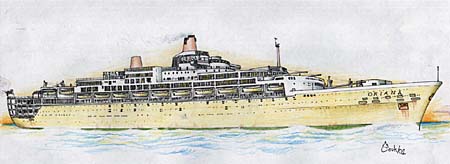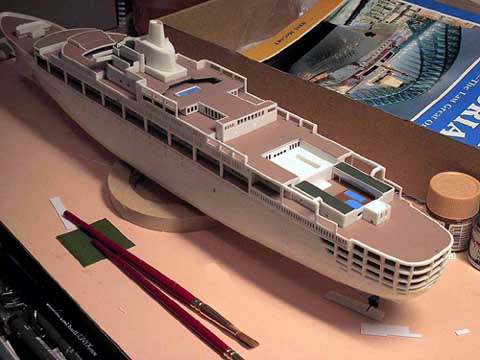
Modelcraft’s 1:500 ‘ORIANA’

Oriana in original ‘corn’ livery. Study by Mike Cook.
Kit No. 500-001
Review by Arjay & Mike Cook
Note: This review was originally posted on the DF in October 2002. It has since been updated to reflect additional information realized about the model.
Nothing sends a spark of excitement throughout the nautical modeling community more than the release of a new subject, especially if the kit is one of a highly recognized, and most loved, pair of passenger liners. In 2000 we were fortunate to have two kits released: the Airfix/Humbrol 1:600 Queen Elizabeth (a re-release), and Modelcraft’s 1:500 Oriana, the latter the subject of this review.
For sake of brevity we will spare readers a recounting of the liner’s history (easily researched by those interested), and a detailed description of parts, of which there are many. The hull and four sprues is molded cream / white, displays minimal flash and are individually bagged. As the kit is designed to be motorized all the necessary components are included, bagged as well. Assembly instructions are, for the most part, adequately illustrated save for two items: the assembly of the motor components, and painting instructions. As for the former, one will not need a degree in electrical engineering to figure all out. However, it is unclear how to replace dead batteries, and whether the hull will require additional ballast to keep her on an even keel. In addition, there is no indication of how the propellers and support bossings are to be configured if one wants to build the model for static display. There are two sets of propellers included in the kit: a set molded in soft black plastic, obviously intended for the motorized option, and a set molded in the same creamy white styrene as the rest of the kit. The blade profiles are very different between the two. There are no plastic shafts included, only the metal ones intended for use with the motor, and for the motorized configuration the bosses that support the shafts seem to be located too far aft, and not to scale. As for painting, some guidance would have been welcomed. The box illustration is a poor representation and deck surfaces are not scribed, making it difficult to determine which were planked, painted steel or covered by some other composite material.
There has been discussion whether this is a re-release of the original Revell offering. We have recently acquired the Revell kit, thus we can state that it is not, and for the most part components are not ‘interchangeable’. They are two very different kits. A detailed part-by-part analysis of the differences between the two (the Revell version more accurate, in terms of completeness, yet neither is 100% correct), is beyond the scope of this review. However, for the purpose of this discussion it can be said that the Modelcraft kit does not represent Oriana as she appeared in 1960 Orient Line configuration, or livery. To render her as she was first introduced into service, as we have decided to do, involves considerable research and scratch building. With respect to documentation, at least when compared to her more celebrated running mate Canberra, Oriana can be elusive. The information is out there yet, difficult to find as most web searches references her younger namesake.
As with any kit there are pluses and minuses. This review, rather than nick-pick all the minor infractions (of which there are many), will focus on the more obvious errors and omissions, as follows:
Decals: A major disappointment. Only the bow name identification is supplied. Missing is the forward funnel house identification, p/s stern identification, draught marks, flags, bow crest and deck-game markings. Curiously, a small patch of green ‘peel-n-stick’ (forward Stadium-Deck covering, which was actually planked), and blue for the Tavern and Dragon Pool, is included. We personally would have preferred less attention to the motor (and associated components), and more to the production of a suitable decal sheet. (A note, re: pools. not all of Oriana’s pools are featured and of those that are, not one is correct. The Revell kit is correct, and complete, in this regard.)
Hull: On the ‘plus’ side it is a one-piece assembly, with minimal flash and only a few wrinkles that can be easily sanded smooth. Ports and other hull openings (hawsers and the like) are, for the most part, deeply molded and can be easily opened fully by utilizing a suitable engraving bit. On the ‘minus’ side, not all hull openings are represented, and for those that are mistakes in groupings and locations abound (example: the 4 x 4-port groupings of both dining rooms are not accurately represented). Curiously, four hull gangways are molded open, to no advantage. In addition, the raised circle of the bow crest, and the waterline / boot-topping scribing, is missing. Indicative of a kit perhaps intended to be an operational toy more than a static display, the location of lower hull features, such as the bow / stern thrusters, and stabilizer fins, is left to the imagination.
Decks: As previously noted, deck surfaces give no indication of material, save for faint scribing on the one piece which constitutes the roof over the forward ‘Stadium’. As not all decks were planked, an indication of which ones actually were would have been appreciated. Even though deck scribing on most kits is not ‘true-to-scale’, it does give a finished topside appearance, something unfortunately Oriana will lack unless one applies planked Evergreen. Other things we have discovered: several missing stairwell openings, the aft ‘Stadium-Deck’ is molded flush (one section was actually raised), the bridge across the Dragon Pool is missing and other irregularities too numerous to detail here.
Superstructure: Oriana has to be the most unusual liner in terms of superstructure design and massing, the reason she has captured our interest. Most bulkhead pieces, with the exception of those behind the open ‘basket’ stern, are molded with open windows and screens, making internal illumination an option to consider. A quick check against plans and photographs have revealed that these openings are not 100% accurate in terms of number and placement, as the p/s pieces appear to be mirror images of one another, not reflecting the true interior architecture. Several other major omissions are apparent: two forward cargo cranes are missing, a lifeboat support frame is missing aft, both port and starboard and the aft ‘Lido-Pool’ enclosure is roofed over. This roof eliminates the cluster of pools that were below, and the four cargo cranes positioned on the top of the port and starboard houses that constituted the Lido-Pool enclosure; thus six cranes will need to be scratch-built. Where this may reflect changes made late in her career (we doubt it), it does not represent Oriana as she appeared in 1960. We intend to entirely scratch-build this area, subject to successful research.

Mike’s model under construction, showing scratchbuilt Lido-Pool area at the stern, and the addition of the ‘missing’ lifeboat frames, port and starboard, aft.
Construction: The 15 stage assembly instructions, although clearly illustrated, leave much to be desired. Assembly will require careful study, and dry fitting of parts (of which many are small), prior to final positioning and gluing. Dry-assembly is all that more tedious owing to several sub-assemblies being composed of more individual components than in reality should be necessary (one curved bulkhead piece, which could have been molded as one, is made up of 4 individual pieces). Complicating matters is the lack of positioning tabs / pins on many pieces. Also of note, several pieces are molded in reverse. Sinkholes appear on the exposed ‘public’ surface rather than on the hidden, adding to ‘orientation’ confusion.
Other errors and omissions exist, and we encourage fellow modelers to take the opportunity to investigate further and share their findings. Overall, this is an excellent release for the price (under $40.00 Canadian). Although the kit, being 1:500 scale, will not provide a suitable study for comparison when placed alongside the 1:600 Canberra, the 1:500 scale provides a higher degree of detail unseen at 1:600, and given the complexity of this liner the larger scale, and attention to detail, is appreciated.
Rating: 8 out of 10 for accuracy and completeness. She is a challenge without doubt, and the challenge is what is most enjoyable!

Mike’s soon to be completed Oriana along side the 1:600 United States and the 1:720 Titanic.
RMD/MC ~ 10/03